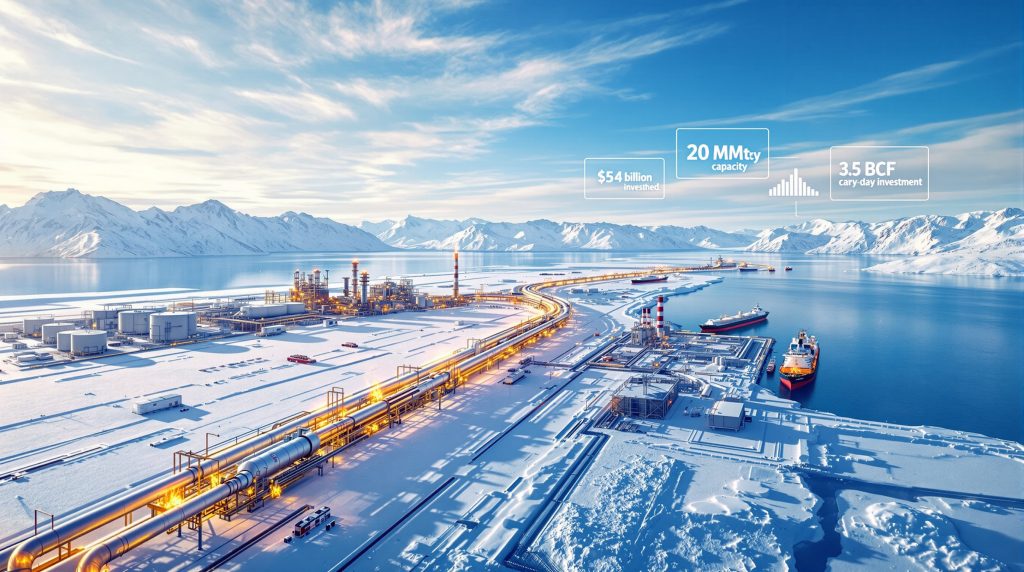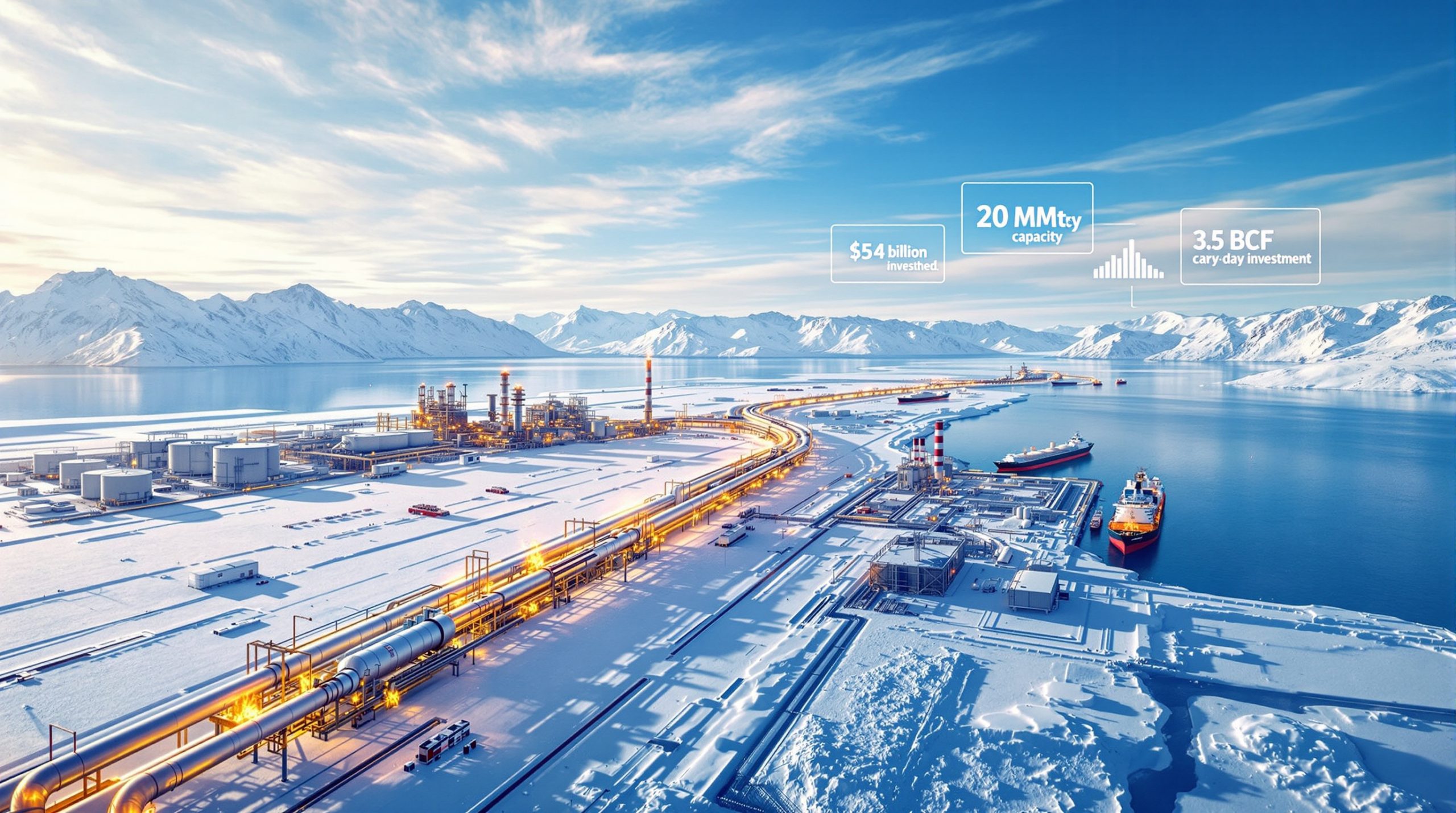The Alaska LNG Project represents one of the most ambitious energy infrastructure developments in North American history, encompassing an integrated system designed to unlock Alaska's vast natural gas reserves. The project's scope includes an 807-mile, 42-inch diameter pipeline connecting the Prudhoe Bay and Point Thomson fields on Alaska's North Slope to a 20 million tonnes per year liquefaction terminal at Nikiski on the Kenai Peninsula.
According to recent project documentation from the Alaska Gasline Development Corporation, the system will process approximately 3.3 billion cubic feet of natural gas daily. This capacity positions the facility to supply roughly 24-27% of Japan's annual LNG consumption, based on Japan's 2023 import volume of 76.2 million tonnes reported by the International Energy Agency.
The integrated approach distinguishes this development from modular Gulf Coast facilities that leverage existing infrastructure networks. Arctic construction conditions and remote logistics create unique engineering challenges that require comprehensive gas treatment capabilities before liquefaction processes can begin.
Project Infrastructure Specifications:
• Pipeline Length: 807 miles with high-pressure transmission capability
• Pipeline Diameter: 42-inch steel construction designed for Arctic conditions
• Daily Capacity: 3.3 billion cubic feet of natural gas throughput
• LNG Terminal: 20 million tonnes per year production capacity
• Gas Sources: Prudhoe Bay and Point Thomson fields integration
The engineering complexity extends beyond typical LNG projects due to permafrost considerations, extreme weather conditions, and the need for specialized ground stabilization technologies. The project requires thermosyphon systems and advanced insulation methods to maintain pipeline integrity across varied terrain conditions.
Key Stakeholders and Development Leadership
A significant ownership transformation occurred in January 2025 when the Alaska Gasline Development Corporation transferred majority control to Glenfarne Alaska LNG, a subsidiary of Glenfarne Energy Transition. This transition marked a critical shift from public to private sector leadership while preserving Alaska's strategic 25% state ownership stake.
Baker Hughes emerged as a pivotal technology partner and investor following definitive agreements signed in November 2025. The Houston-based company brings proven LNG expertise from U.S. Gulf Coast and Qatari operations, supplying essential LM6000 aeroderivative gas turbines and main refrigerant compressors for the facility. This equipment provider partnership has strengthened the project's technical foundation significantly.
Glenfarne committed approximately $150 million in pre-final investment decision costs, demonstrating substantial financial backing for development phases. Engineering firm Worley Ltd conducts the critical Front-End Engineering and Design study, with completion expected by December 2025.
Major Project Participants:
| Stakeholder | Role | Contribution |
|---|---|---|
| Glenfarne Alaska LNG | Lead Developer | Majority ownership, $150M pre-FID funding |
| Alaska Gasline Development Corp | State Partner | 25% ownership retention |
| Baker Hughes | Technology Provider | LM6000 turbines, refrigeration equipment |
| Worley Ltd | Engineering Contractor | FEED study completion |
| FERC | Regulatory Authority | Construction and operation authorization |
Commercial interest has exceeded initial projections, with more than 50 companies expressing interest in supply and construction contracts valued at over $115 billion. This includes participants from the United States, Japan, South Korea, Taiwan, India, Thailand, and European Union markets.
The project benefits from Baker Hughes' operational experience across multiple LNG facilities, including deployments at Sabine Pass, Cameron LNG, and Corpus Christi terminals in the Gulf Coast region. Qatar's Barzan Gas Complex and North Field installations provide additional technical credibility for Arctic applications.
Strategic Geographic Advantages for Asian Markets
Alaska's positioning creates compelling logistics advantages for Asian LNG buyers compared to traditional U.S. Gulf Coast export routes. Shipments from the Nikiski terminal to major Asian destinations require less than 10 days transit time, effectively cutting delivery schedules nearly in half compared to Gulf Coast alternatives.
The direct Pacific routing eliminates Panama Canal constraints while enabling larger vessel utilisation. Standard Panamax vessels accommodate approximately 65,000-75,000 cubic metres of LNG cargo, while Nikiski's deep-water capabilities can support Q-max class carriers exceeding 170,000 cubic metres, providing superior unit economics through scale.
Transit Time Analysis:
• Alaska to Japan: 8-10 days direct Pacific route
• Gulf Coast to Japan: 18-20 days via Panama Canal
• Alaska to South Korea: 9-11 days without canal restrictions
• Distance Advantage: Approximately 3,800-4,200 nautical miles vs. 7,500-8,000 miles from Gulf Coast
The geographic positioning becomes increasingly valuable as Asian economies pursue supply diversification strategies. Current geopolitical dynamics following the Russia-Ukraine conflict have intensified focus on reliable, Western-aligned energy partnerships.
Furthermore, freight cost advantages stem from shorter voyage distances and reduced canal fees. Moreover, natural gas price trends suggest potential savings of $0.30-0.60 per MMBtu compared to Gulf Coast routing, though final economics await detailed project cost analysis through the FEED study completion.
The shorter Pacific route avoids multiple geopolitical chokepoints including the Suez Canal, Strait of Malacca congestion, and Panama Canal capacity limitations that can delay or increase costs for alternative routes.
International Market Demand and Commercial Commitments
Preliminary commercial agreements have secured more than 60% of the planned 20 million tonnes per year capacity, indicating robust international buyer interest. Japanese utilities JERA Co. and Tokyo Gas Co. have signed non-binding offtake commitments, while South Korea's POSCO International has expressed similar commercial intent.
JERA represents Japan's largest LNG buyer as a joint venture between Tokyo Electric Power and Chubu Electric Power, with combined annual procurement exceeding 35 million tonnes. Tokyo Gas, as Japan's premier city gas utility, maintains diversified LNG sourcing portfolios totaling approximately 12-15 million tonnes annually.
Regional LNG Import Demand (2024-2030 Projections):
| Region | Current Demand (MMtpy) | Growth Trajectory | Market Drivers |
|---|---|---|---|
| Japan | 75-85 | Stable to modest decline | Coal-to-gas switching, nuclear limitations |
| South Korea | 45-55 | Steady 2-3% annual growth | Industrial expansion, power generation |
| China | 80-120 | Rapid 8-12% expansion | Economic growth, air quality policies |
| Taiwan | 15-20 | Consistent 3-5% growth | Energy security, diversification |
| Thailand | 8-12 | Emerging market development | Industrial development, power sector |
Commercial expressions of interest extend beyond Northeast Asia to include Taiwan, India, Thailand, and European Union buyers seeking supply diversification. The timing aligns with Asia's accelerating natural gas consumption driven by coal retirement policies and nuclear capacity constraints in key markets.
In addition, China's LNG import growth presents the largest demand opportunity, with projections indicating potential doubling of current consumption by 2030. However, geopolitical considerations may limit direct Chinese participation in favour of allied Asian partners.
However, European interest reflects ongoing efforts to reduce Russian energy dependence following 2022 supply disruptions. While Alaska LNG's primary focus targets Asian markets, European buyers could provide additional commercial flexibility and pricing leverage.
Development Timeline and Critical Milestones
The Alaska LNG Project follows a carefully structured development sequence with defined decision points and construction phases. Front-End Engineering and Design completion by December 2025 represents the immediate critical milestone, providing detailed cost estimates and technical specifications necessary for final investment decisions.
Pipeline construction authorisation could commence in early 2026 following regulatory approvals and financing package completion. The liquefaction terminal development would begin approximately two years later, allowing for staggered financing and construction management whilst maintaining integrated project coordination.
Development Phase Schedule:
• FEED Study Completion: December 2025 – Engineering finalisation and cost validation
• Pipeline Final Investment Decision: Early 2026 – Construction authorisation and financing closure
• Terminal Final Investment Decision: Late 2026 to early 2027 – Export facility approval
• Pipeline Construction: 2026-2029 – 807-mile installation across Alaska
• Terminal Construction: 2028-2031 – LNG facility development and commissioning
• First Gas Production: 2031-2032 – Commercial operations commencement
The phased approach enables independent financing structures for each major component whilst preserving overall project integration. Pipeline construction can proceed with traditional project finance models, while the LNG terminal may require more complex offtake-backed financing arrangements.
Consequently, risk mitigation strategies include early contractor engagement, equipment procurement commitments, and staged construction sequencing to minimise weather-related delays. Arctic construction windows typically extend from May through September, requiring precise scheduling coordination across multiple construction seasons.
Domestic Energy Benefits for Alaska
Beyond export revenue generation, the Alaska LNG Project prioritises domestic energy security by providing affordable natural gas access to Alaskan communities currently dependent on expensive imported diesel fuel for power generation and heating applications.
Rural Alaska faces some of the highest energy costs in North America, with residential heating expenses often exceeding $0.25-0.35 per therm compared to U.S. national averages below $0.15 per therm. Natural gas distribution through the integrated pipeline system could reduce these costs by 30-45% whilst supporting broader economic development initiatives.
Alaska Energy Cost Reduction Potential:
| Energy Application | Current Cost | Projected Gas Cost | Savings Potential |
|---|---|---|---|
| Residential Heating | $0.25-0.35/therm | $0.12-0.18/therm | 30-45% reduction |
| Commercial Power | $0.18-0.28/kWh | $0.10-0.16/kWh | 25-40% reduction |
| Industrial Applications | $15-25/MMBtu | $8-12/MMBtu | 35-50% reduction |
The project design incorporates domestic supply priorities before export allocation, ensuring local energy needs receive guaranteed access. This approach addresses long-standing Alaskan concerns about resource extraction without corresponding local benefits.
Small-scale distribution systems could extend natural gas access to communities along the pipeline route, supporting residential, commercial, and industrial users. For instance, fertiliser production, petrochemical processing, and other value-added industries could develop around reliable, low-cost natural gas availability.
Electric power generation represents another significant opportunity, with natural gas potentially displacing diesel generators that currently provide electricity to many Alaskan communities. Combined heat and power applications could further enhance efficiency and cost savings for large facilities.
Environmental and Regulatory Compliance Framework
The Federal Energy Regulatory Commission has provided construction and operation authorisation following comprehensive environmental impact assessments involving multiple federal agencies. The regulatory review process addressed wildlife protection measures, permafrost considerations, and lifecycle greenhouse gas emissions throughout the project development.
Environmental compliance measures include advanced wildlife corridor preservation systems, state-of-the-art leak detection technologies, and carbon capture readiness for potential future implementation. The project design incorporates best practices from existing Arctic infrastructure whilst meeting current environmental standards for large-scale energy developments.
Regulatory Approval Status:
• FERC Authorisation: ✓ Construction and operation permits secured
• Environmental Impact Statement: ✓ Completed with mitigation measures
• State Environmental Permits: ✓ Alaska regulatory approvals in progress
• International Trade Authorisation: ✓ U.S. Department of Energy export licences
• Final Construction Permits: ⏳ Pending FEED study completion
The environmental impact statement addressed concerns regarding caribou migration patterns, marine ecosystem protection, and indigenous community consultation requirements. Mitigation measures include seasonal construction restrictions, wildlife crossing structures, and comprehensive monitoring protocols.
Furthermore, climate impact considerations focus on upstream emission reductions through advanced gas processing technologies and downstream displacement of higher-carbon fuel sources in importing countries. Life cycle assessments demonstrate potential net emissions reductions when Alaska LNG displaces coal-fired power generation in Asian markets.
Permafrost engineering represents a critical technical challenge requiring specialised foundation systems and thermal management protocols. The pipeline design incorporates elevated sections, insulated supports, and refrigeration systems to prevent ground thawing and maintain structural integrity.
Investment Structure and Financing Challenges
The $44 billion capital requirement represents one of the largest single energy infrastructure investments in U.S. history, necessitating sophisticated financing structures and comprehensive risk mitigation strategies. Project economics depend heavily on converting preliminary commercial agreements into binding long-term sales contracts with creditworthy counterparties.
However, financing complexity increases due to Arctic construction conditions, integrated pipeline requirements, and extended development timelines spanning multiple years. Traditional investment strategy components require adaptation to accommodate the unique technical and commercial aspects of Alaska's remote energy infrastructure environment.
Investment Structure Framework:
| Funding Source | Estimated Allocation | Risk Profile | Terms |
|---|---|---|---|
| Senior Project Finance Debt | 60-70% | Lowest risk, asset-backed | 15-20 year terms |
| Equity Investment | 25-35% | Development and market risk | Returns tied to project cash flows |
| Government Support | 5-10% | Policy and strategic backing | Potential loan guarantees |
| Strategic Partnerships | Variable | Technology and commercial risk | Equipment financing, offtake backing |
Debt financing depends on securing investment-grade offtake agreements with Japanese, South Korean, and other Asian utilities that provide stable cash flow projections. Export credit agencies from participating countries may provide additional financing support through guaranteed facilities.
The integrated nature of the project enables some financing advantages through economies of scale and operational synergies between pipeline and terminal components. Nevertheless, construction risk management becomes more complex due to the sequential development phases and weather-dependent construction windows.
Project financing terms and investment returns involve significant risks including construction delays, cost overruns, commodity price volatility, and changes in regulatory or market conditions. Potential investors should conduct independent due diligence and consult qualified financial advisors.
How Does Alaska LNG Compare to Other U.S. LNG Projects?
The Alaska LNG Project's integrated approach contrasts sharply with modular Gulf Coast developments that benefit from existing pipeline infrastructure and industrial support systems. While this comprehensive scope creates higher capital intensity, it offers superior control over the entire value chain and potentially enhanced economics for long-distance export markets.
The Alaska LNG project overview details how the 20 million tonnes per year capacity exceeds most individual U.S. LNG terminals, approaching the scale of major Qatari facilities. However, the integrated pipeline component distinguishes this development from conventional Gulf Coast projects that utilise existing interstate gas transportation networks.
U.S. LNG Project Comparison Analysis:
| Project | Capacity (MMtpy) | Capital Cost | Key Differentiators |
|---|---|---|---|
| Alaska LNG | 20.0 | $44 billion | Integrated pipeline, Arctic location |
| Calcasieu Pass | 10.0 | $4.5 billion | Modular floating design |
| Plaquemines LNG | 20.4 | $10 billion | Gulf Coast infrastructure access |
| Rio Grande LNG | 27.0 | $18 billion | Brownsville strategic location |
| Golden Pass LNG | 15.6 | $10 billion | Qatar partnership, existing infrastructure |
Geographic advantages for Asian markets provide Alaska LNG with unique competitive positioning despite higher capital costs. The 8-10 day transit time to major Asian destinations creates structural cost advantages that may offset higher production expenses through reduced transportation costs.
Market timing presents both opportunities and challenges. New LNG supply from Qatar's North Field Expansion and competing U.S. projects could create oversupply conditions by 2028, potentially affecting pricing structures and contract negotiations.
However, Alaska's geographic position, integrated supply chain control, and established commercial relationships with Asian buyers may provide competitive resilience during market downturns. The project's scale enables operational flexibility and cost optimisation opportunities unavailable to smaller developments.
Political Support and Economic Development Drivers
The Trump administration's renewed emphasis on energy exports as diplomatic leverage has created favourable policy conditions for large-scale LNG developments. Federal officials view Alaska LNG as strategically important for strengthening relationships with Asian allies whilst reducing their dependence on alternative energy suppliers.
Alaska's congressional delegation has actively promoted the project through trade missions and diplomatic engagement initiatives. Senator Dan Sullivan led trade missions to Japan and South Korea during 2025, building relationships with potential Asian customers and government officials.
Governor Mike Dunleavy's administration has prioritised the development as central to Alaska's economic diversification strategy beyond traditional oil revenues. In addition, the Alaska oil and gas drilling policy framework has evolved to support state officials' emphasis on the project's potential to generate sustained employment, tax revenues, and economic development across multiple sectors.
Political Support Framework:
• Federal Policy Alignment: Energy export promotion and alliance strengthening
• State Government Priority: Bipartisan legislative and executive support
• Congressional Advocacy: Active promotion through trade missions and diplomacy
• International Relations: Asian partnership development and government engagement
• Regulatory Environment: Streamlined approval processes and policy coordination
Economic development benefits extend beyond direct project employment to include supporting industries, infrastructure improvements, and community development initiatives. Construction phases could generate thousands of direct jobs whilst stimulating broader economic activity throughout Alaska.
The project aligns with broader U.S. strategic objectives including energy security enhancement, trade deficit reduction, and geopolitical influence expansion in the Asia-Pacific region. These strategic considerations provide additional political momentum beyond purely commercial drivers.
Market Conditions and Risk Assessment
Global LNG market dynamics present both significant opportunities and substantial challenges for Alaska LNG's commercial viability. New supply capacity from Qatar's North Field Expansion and competing U.S. projects could potentially create oversupply conditions by 2028, affecting long-term contract negotiations and pricing structures.
However, Asia's accelerating gas demand growth, European supply diversification requirements, and the project's inherent geographic advantages may provide sufficient market support despite increased competition. The integrated nature of Alaska LNG offers operational flexibility and cost optimisation capabilities that could prove decisive during competitive market conditions.
Market Risk Analysis:
| Risk Factor | Impact Level | Mitigation Strategy | Timeline |
|---|---|---|---|
| Supply Competition | High | Geographic advantage, delivery cost savings | 2028-2035 |
| Asian Demand Growth | Medium | Long-term contract security, diversification | Ongoing |
| Price Volatility | High | Flexible pricing mechanisms, cost optimisation | Variable |
| Regulatory Changes | Medium | Compliance excellence, stakeholder engagement | Ongoing |
| Technology Implementation | Low | Proven equipment, operational experience | 2026-2031 |
Asian LNG demand fundamentals remain supportive despite near-term market uncertainties. Japan's commitment to maintaining LNG import levels, South Korea's industrial expansion, and China's continued economic growth provide substantial demand foundations for new supply capacity.
European market conditions create additional opportunities for supply diversification beyond primary Asian markets. While transportation economics favour Asia-Pacific routing, European contracts could provide commercial flexibility and pricing leverage during market negotiations.
Furthermore, climate policy developments across importing regions increasingly favour lower-carbon LNG supplies with transparent emission profiles. Alaska's advanced gas processing technologies and potential for renewable power integration could provide competitive advantages in environmentally-conscious markets.
What Are the Key Risk Factors for Alaska LNG?
The Alaska LNG Project development involves substantial financial, technical, and market risks that potential stakeholders must carefully evaluate. These challenges reflect the project's unprecedented scale, remote location, and complex international commercial arrangements.
Construction risks present the most immediate concerns, particularly given Alaska's harsh Arctic conditions and limited construction seasons. Weather-related delays, permafrost complications, and remote logistics could significantly impact project schedules and costs.
Moreover, global industry evolution trends and energy exports challenges demonstrate how market volatility affects large-scale energy projects across different regions.
Primary Risk Categories:
• Construction and Technical Risks: Arctic conditions, permafrost engineering, integrated system complexity
• Market and Commercial Risks: Price volatility, competition from new supplies, demand fluctuations
• Financial and Investment Risks: Capital cost escalation, financing availability, currency exposure
• Regulatory and Political Risks: Policy changes, environmental requirements, international trade conditions
• Operational and Performance Risks: Equipment reliability, transportation logistics, long-term maintenance
Market competition from new LNG supplies globally could affect pricing power and contract negotiations. Qatar's massive North Field Expansion and numerous U.S. Gulf Coast projects may create oversupply conditions during Alaska LNG's target commercial operation period.
The project's ultimate success depends on successful completion of engineering studies, securing adequate financing arrangements, converting commercial expressions of interest into binding agreements, and executing construction activities within budget and schedule parameters whilst maintaining environmental and safety compliance standards.
Consequently, potential investors and project stakeholders must conduct thorough due diligence and risk assessment before making financial commitments. The combination of technical complexity, market uncertainties, and substantial capital requirements necessitates comprehensive risk management strategies and contingency planning throughout the development process.
Looking to capitalise on major energy infrastructure developments?
Discovery Alert's proprietary Discovery IQ model identifies significant ASX mineral discoveries in real-time, helping investors spot potential opportunities before the broader market. Explore how historic discoveries have generated substantial returns and begin your 30-day free trial today to gain a market-leading edge.




